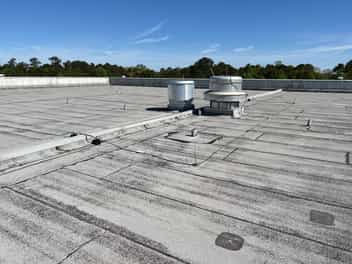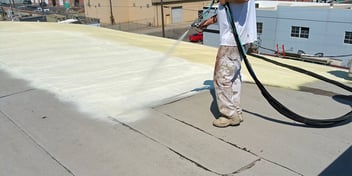- Home »
- Learningcenter »
- Built up spray foam
Built-Up vs. Spray Foam Roofing: The Pros and Cons of Both
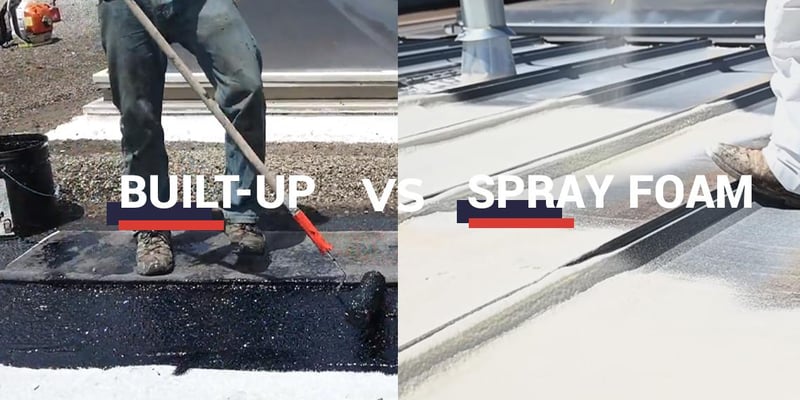
When it’s time to replace the roof on your commercial building, there are countless factors to consider. Not only do you want to think about your budget and the lifespan of different roofing systems, but you’ll also want to factor in how much maintenance is required, the energy efficiency of various roof systems, and much more.
In this article, we will compare built-up roofing– one of the oldest commonly used low-slope roofing systems– and spray foam roofing– an increasingly popular roof coating that is incredibly energy efficient.
What Is Built-Up Roofing?
Built-up roofing systems have been used in the United States on flat-roof buildings for more than a century. The installation process involves applying layers of tar or asphalt along with supporting fabrics before applying the final layer of gravel or stone.
There are two primary types of built-up roofing systems; the key difference between them is how large the rocks are used in the final layer.

The first type of built-up roofing system is tar and gravel. Using more coarse rocks that are smaller– between 0.25” and 0.5”– these roofs are attached using a bitumen-based chemical. This chemical can either be cold applied or heat applied.
The second type of built-up roofing system is a ballasted system. This type of built-up roof uses larger gravel that typically ranges in size from 1.5” to 2.5”.
The gravel isn’t sealed down in this roofing system in the same way it is in a tar and gravel roof. Instead, they are piled on top of a waterproof membrane. This membrane is actually held in place by the weight of the large rocks and isn’t sealed down.
What Is Spray Foam Roofing?
Frequently referred to as SPF, spray polyurethane foam is a substance sprayed onto an existing roof as a liquid and then expands into a foam. This creates a seamless, solid layer that covers an already installed roof.
The technology for SPF roofs has been around for more than sixty years. It is commonly used on commercial, industrial, and agricultural buildings.
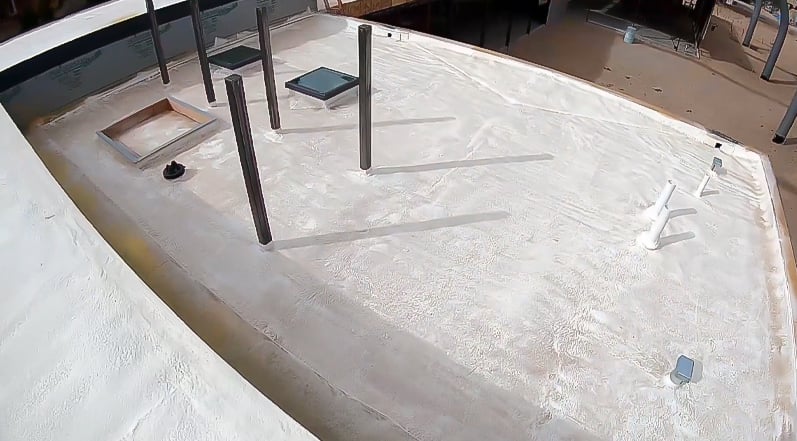
Spray foam roofing is applied to an existing roof and can be sprayed onto the following roofing materials for added protection and additional longevity:
- ● TPO roofs
- ● Modified bitumen roofs
- ● Metal roofs
- ● EPDM roofs
- ● Built-up roofs
Spray foam is known for its ability to expand and conform to the material to which it is applied, which means that it can effectively protect and preserve existing roofs of many different types.
The Pros of Built-Up Roofing
Built-up roofs can potentially last up to forty years on a commercial building if they are installed and maintained properly. Let’s look at some of the reasons you might want to go with a built-up roof over other options for your new roofing system.

Traction
One notable benefit of built-up roofs is that they provide excellent traction regardless of the season. Since the top layer is made of gravel, there is excellent grip even in the coldest seasons of the year.
Building-up roofs can be a reasonable choice if you’re concerned about maintaining the ability to walk on your roof throughout the year. This is particularly true when compared to other popular commercial roofing systems like TPO, which can get incredibly slippery after a snowfall.
Impact Resistance
Your roof is well protected from impact when covered in a gravel layer. Whether you’re concerned about falling branches, hail damage, or other types of impact, built-up roofs are highly impact resistant.
Lifespan
When you install a built-up roof, you have options when it comes to how many layers you install. It is commonly said that a built-up roof will last five years for every layer installed. This means that it is very possible to install a built-up roof that will last for twenty to forty years.
Maintenance
The maintenance required for built-up roofing systems is very low compared to other types of roofing systems. You may need to periodically add more gravel to the top surface. That said, it can be difficult to find leaks when they occur, which we’ll discuss under the cons of built-up roofing.
UV Resistant
The gravel in a built-up roof system acts as a barrier that protects your roof’s underlayers from the sun’s rays.
Fire Resistant
Another pro of built-up roofs is their fire resistance. Since the top layer is gravel or stones, they protect the underlayers from sparks or falling ash.
Easy to Repair
It is fairly easy to repair built-up roofs when necessary. This generally consists of cutting away layers of the membrane and then replacing them with a new membrane. You can then add additional layers on top to bring the roof back to its original condition.
Application Isn’t Weather Dependent
If you are cold-applying a built-up roof, you don’t have to worry about cold weather negatively impacting the installation process.
The Cons of Built-Up Roofing
Built-up roofs have become less popular in recent years as other roofing systems have become more widely used on commercial buildings. Here are some of the downsides of built-up roofs that you’ll want to consider.
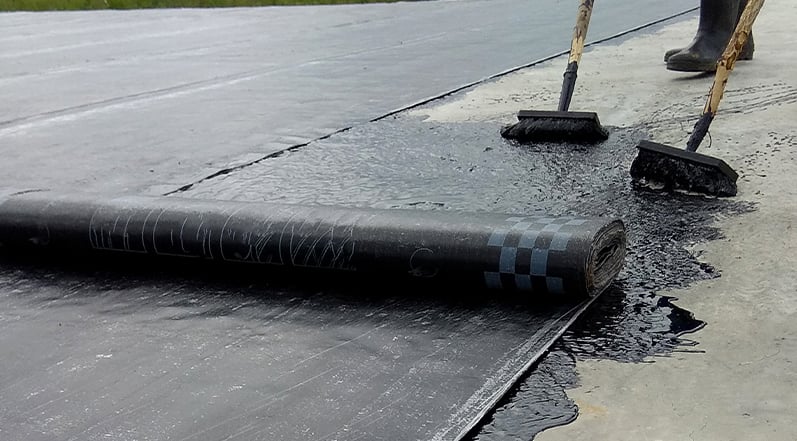
Difficult to Find Leaks
One of the disadvantages of built-up roofing is that it can be hard to identify the source of leaks. This is due to the fact that the top layer is covered with gravel and rocks that obscure one’s ability to easily discover where a leak is coming from.
Heavy
Ballasted built-up roofs are fairly heavy roof systems, but the precise weight will depend on how thick your layer of stone is. Per square foot, a ballasted roof can weigh between ten and twenty-five pounds per square. You’ll therefore want to ensure that your building can withstand the weight if you choose to go with a ballasted roof.
Gravel Can Get Blown Off By Heavy Wind
Strong wind storms can blow the gravel off the roof, which is another negative aspect of built-up roofing systems. Not only can this reduce the amount of gravel on top of your roof over time, but it could also potentially cause damage to nearby structures or other parts of the building.
Built-Up Roofs Are Becoming Less Popular
There are a number of other low-slope and flat-roof systems that are becoming more popular these days, such as TPO and PVC. This isn’t necessarily a reason not to install a built-up roof, but it’s worth knowing that their popularity is waning.
Susceptible to Mold
If gravel ends up clogging the drain or moisture is trapped between the rocks, mold can form. This is one of the reasons it’s important to inspect your built-up roof on a regular basis to ensure that water is draining properly.
Slower Installation Process
Other types of flat and low slope roof systems are faster to install than built-up roofs. This can mean that there are increased labor costs compared to other systems.
The Pros of Spray Foam Roofing
Properly installed and maintained spray foam roofs can help to protect your existing roof and increase its lifespan for decades. Here are some of the most compelling reasons you might want to install an SPF roof on your commercial building.

Lifespan
Depending on the thickness of your SPF roofing application, an SPF system has a stated lifespan of ten to twenty years. That being said, a properly installed and maintained SPF roof can last for many decades.
Installation
It’s very easy to install SPF roof coatings compared to other types of roofing systems. However, professional contractors will need to use a hose to apply the spray polyurethane foam to the roof before spraying a silicone layer.
The fact that SPF is quick and easy to install doesn’t just save you money on labor, but it also means that you won’t have to deal with much in the way of interruption to the normal operation of your commercial facility.
Weather Resistance
SPF roof coatings are particularly resistant to wind. This can be a great option if your commercial building is in an area that frequently deals with storms accompanied by heavy wind. The wind uplift rating is roughly 160 lbs per square inch for SPF roofs.
In addition to being resistant to wind, SPF roofs are also resistant to UV radiation. This is due to the silicone layer added on top of the SPF, which helps make the roof more durable.
Environmentally Friendly
Another benefit of SPF roof coatings is that there is very little waste created during the installation process, particularly if none of the existing roofing materials are going to be removed prior to application. Additionally, it helps to decrease what is known as the urban heat island effect.
Energy Efficiency
SPF begins to cure as soon as it is sprayed. During the curing process, gas-filled bubbles start to float to the surface and end up drying with a spongy texture. When fully cured, SPF creates an excellent insulative layer on your roof.
In fact, the highest R-value per inch you can find for a roofing system comes from spray foam roofing. This means that your cooling costs can be reduced during the summer. Additionally, your HVAC system won’t need to work nearly as hard to cool your building, meaning that it will likely require less maintenance and will have a longer lifespan.
Versatile
Spray foam roofs are most commonly applied to commercial buildings, but in some cases, they will also be used in residential applications. It can be applied to a wide variety of existing roofing materials, meaning that it is a viable option for many commercial buildings whose roofs could use some additional protection.
Fills Cracks, Holes, and Gaps
One of the great things about SPF is that it is very effective at filling in holes, cracks, and gaps in your roof. This is because the product goes on as a liquid but then expands to create a foam that fills any open spaces. Beyond this, professional roofing contractors can adjust the roof levels easily using this product, which can reduce the risk of ponding.
The Cons of Spray Foam Roofing
Of course, there are always two sides to every coin. Before you decide that SPF is the right choice for your commercial building, take a look at some of the disadvantages of this type of roof system.
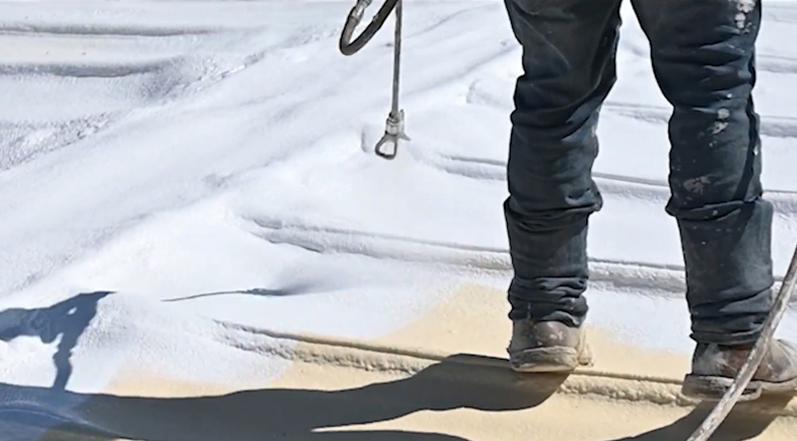
Risk of Overspray
One of the inherent risks that come along with spraying SPF is the potential for overspray. Overspray is when the wind carries the foam away from the roof or the foam flies off the edge of the building. This means that SPF can end up in unideal and unintended spots.
In order to make sure that SPF doesn’t cause this type of issue, a number of precautions should be taken prior to application. This includes using some type of plastic or cardboard protective shield along the roof edges and covering any cars parked near the building.
Temperature Limitations During Installation
SPF roofs can’t be installed in all seasons– they require a minimum temperature in order to cure properly. With a minimum temperature of 55 degrees Fahrenheit, SPF roofs can typically only be installed during the warm months of the year. Beyond that, rain or other inclement weather can impact the curing process and, therefore, the efficacy of the final product.
Impact Resistance
Spray polyurethane foam is rated to resist roughly forty pounds per square inch, which is a lower impact resistance rating than other popular types of flat roofing systems like PVC and TPO. However, SPF roofs are strong enough to walk on, but they aren’t always as capable of avoiding damage from events like hailstorms.
Luckily, your SPF roof can have an increased resistance to impact by applying a surface layer of granules. If you live in a place where hail storms are common or you’re otherwise interested in increasing the impact resistance of your roof, you’ll want to talk to your roofing contractor about this option.
Requires Skilled Contractors
SPF roofs definitely aren’t a good DIY project. You’ll want to hire a professional contractor that is very experienced in the application of SPF. There are many factors to consider when applying SPF, such as temperature, wind conditions, moisture level, the potential for overspray, and more. Skilled contractors are essential when installing an SPF system.
Built-Up Vs. Spray Foam Roofing: Which Is Right for You?
Whether you decide you want a built-up roof, a spray foam roof coating, or one of the other popular commercial building roofing systems, Colony Roofers is here to help. Serving the greater Atlanta area and specializing in offering the highest-quality roofs for the most affordable prices, we would love to answer any questions you have about your commercial roof and the various options available.
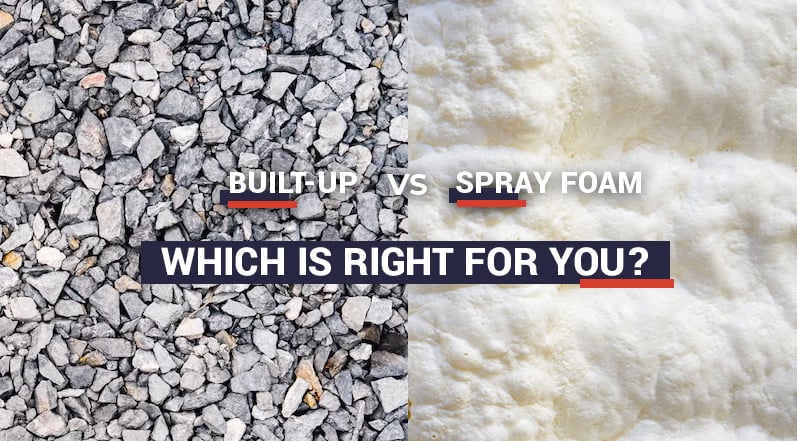
Are you ready to start receiving quotes for built-up, spray foam, or another type of roofing system? If so, contact us today for a free estimate.
Frequently Asked Questions
What are the main differences between built-up roofing and spray foam roofing systems?
Spray foam roofing systems are composed of two parts that are mixed together at the nozzle of a sprayer and then sprayed onto the roof’s surface. The resulting foam expands and adheres to the roof, creating an airtight seal that can last up to 20 years. This type of roofing is generally used in residential settings.
The main difference between the two types of roofing systems is their composition and installation process. Built-up roofing requires more time and labor for installation than spray foam roofing, which can be applied quickly and efficiently with minimal manual labor. Built-up roofing also requires regular maintenance, whereas spray foam roofs can remain maintenance-free for many years. Additionally, spray foam roofs are more energy efficient than built-up roofs, as they create an airtight seal that reduces air infiltration.
How do the costs of built-up roofing and spray foam roofing compare?
The cost of built-up roofing and spray foam roofing can vary significantly depending on the size of your roof, the quality of materials used, and the complexity of the installation process. Generally speaking, built-up roofing systems tend to be more affordable upfront than spray foam roofing systems. While the initial investment in a built-up roof may be cheaper, it is essential to consider long-term costs such as repair, maintenance, and energy efficiency when deciding which system is right for your business.
Built-up roofing systems typically require more frequent repairs and maintenance than spray foam roofs due to their more complex design. Additionally, built-up roofs may require more energy to maintain a comfortable temperature inside the building due to their heavier material composition. Over time, these costs can add up and may exceed the upfront costs of a spray foam roof.
On the other hand, spray foam roofing systems are typically more expensive upfront than built-up roofs but often require less maintenance and can help reduce energy costs over time. Spray foam roofing systems create an airtight seal that helps keep hot air out during summer and cold air out during winter, leading to significant energy savings. Additionally, spray foam roofs do not need to be replaced as frequently as built-up roofs, meaning that ownership costs over time are often lower.
How do the installation processes for built-up roofing and spray foam roofing differ?
On the other hand, spray foam roofing systems can be installed much faster than traditional built-up roofing systems. The installation process for a spray foam roof begins with a chemical reaction between two components – a polyol resin and an isocyanate catalyst. This mixture is then applied to the roof's surface and allowed to expand, creating a seamless, waterproof layer that provides superior insulation. An installer could complete the entire process in just one day.
Regarding installation processes, built-up roofs are more labor-intensive and time-consuming than spray foam roofs. However, both systems offer their own benefits, so choosing the right option for your business should depend on your specific needs and budget.
 Call (678) 365-3138
Call (678) 365-3138

